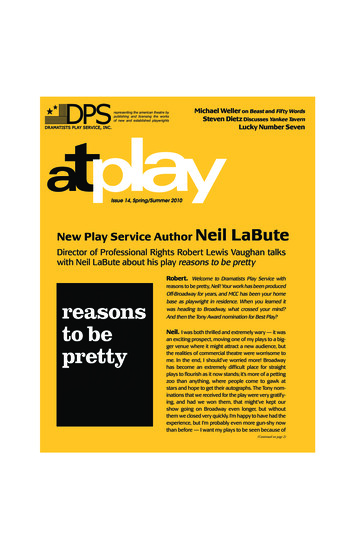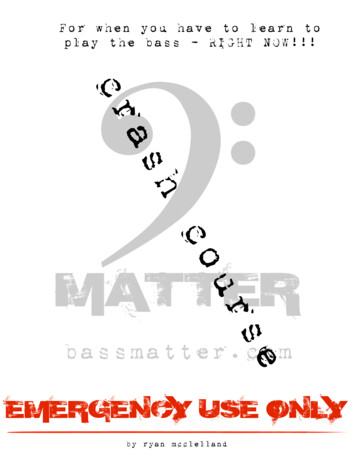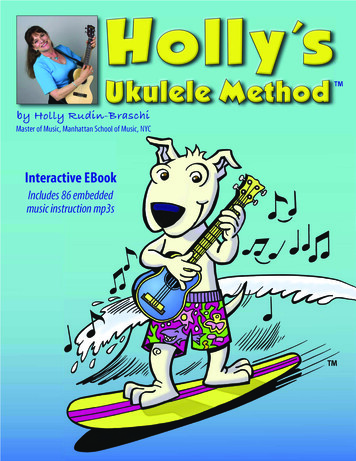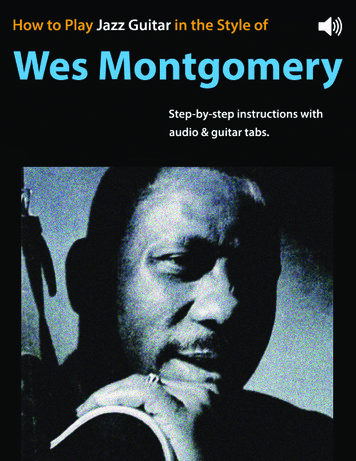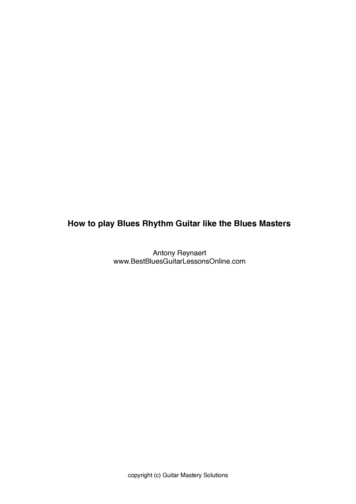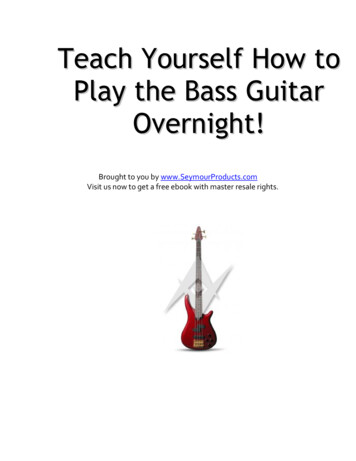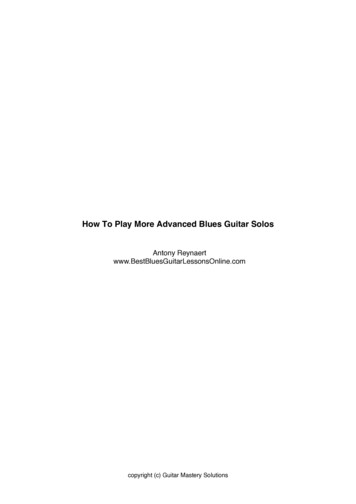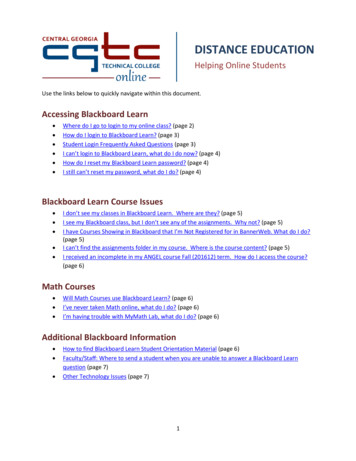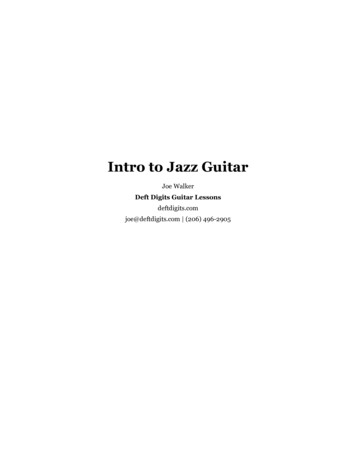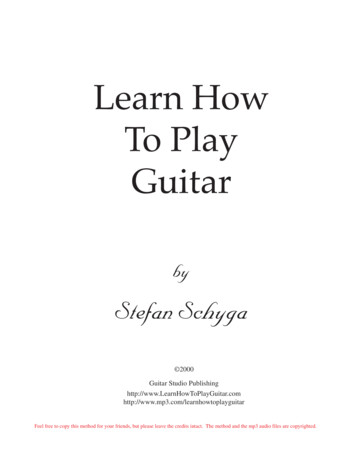
Transcription
Learn HowTo PlayGuitarbyStefan Schyga 2000Guitar Studio //www.mp3.com/learnhowtoplayguitarFeel free to copy this method for your friends, but please leave the credits intact. The method and the mp3 audio files are copyrighted.
About The AuthorStefan Schyga received his MastersDegree in Music Eduction in May of1991. During his studies he alsotaught the Beginning and Intermediate guitar classes at The Universityof Texas at El Paso. Teaching theseclasses and having had problemsfinding a suitable method for his private studio inspired him to write anew and different guitar method forthe adult learner. This new methodattempts to teach the basics of classical guitar playing in a more effective and especially more interestingmanner.“With talent and skill beyond imagination, this artist defies the laws of the undergroundartist, playing classical/flamenco guitar with a flood of emotion and heart. His sprawlingand majestic work forces one to conjure up magical warm imagery. All of the songs on hislatest album were recorded live in the studio and are absolutely spectacular representationsof the beauty that still lives and breathes in music from around the world.” -December1999, riffage.comFrom 1993-1996 Stefan was the Classical/Flamenco Guitar of Telarc Recording Artist LaVienta.La Vienta has released 3 albums with Telarc International. that being sold in 28 countriesaround the globeDuring these years La Vienta made their mark on the international music scene with theirfresh approach to acoustic guitar music. They performed from San Francisco to New York,climbed to #17 on Billboards Contemporary Jazz charts and to #4 of Mexico City’s JazzCharts.Feel free to copy this method for your friends, but please leave the credits intact. The method and the mp3 audio files are copyrighted.
Since the Stefan has released three successful solo albums:A Little World Music: Solo Spanish GuitarSpanish Soul: Featuring the Acoustic World EnsembleXO & Friends: Featuring Ricky Malichi & Curt Warren.Stefan’s latest success is reflected in the fact that his music was chosen to be featured on the first everretail mp3 CD featuring Billy Wyman (Rolling Stones) This CD has World Wide distribution and willbe carried by the Walmart stores in the US. In addition he was also featured on Riffage’s 2nd MP3 CDthat was distributed with Spin Magazine.You can download most of his music for free at:http://www.mp3.com/isrYou can download free classical sheet music & mp3s at:http://www.mp3.com/guitarstudioHis music is also featured on Riffage.com’s newest compilation disks.The Computer Graphics and the Word Processing were done by Jason Myre.The illustrations were created by Sam Cassiano.Feel free to copy this method for your friends, but please leave the credits intact. The method and the mp3 audio files are copyrighted.
Table of ContentsPrefaceIntroductionChoice of GuitarMain Parts of the GuitarLesson 1Tuning the GuitarBasic Terms and Symbols in MusicLesson 2The Notation of RhythmsLesson 3Rhythmic ExercisesLesson 4Terms and Symbols in Guitar MusicLearning Pitches on the GuitarNotes on the High E-String (first string)Lesson 5Notes on the B-String (second string)Dotted RhythmsLesson 6Notes on the B and E-StringsLesson 7Notes on the G-String (third string)Lesson 8Notes on the D-String (fourth string)Lesson 9Notes on the G and D-StringsLesson 10Notes on the A-String (fifth string)Lesson 11Notes on the low E-String (sixth string)Note DrillLesson 12AccidentalsLesson 13RestsLesson 14Reading Guitar Music in 2 to 4 PartsReference SheetLesson 15Two Beginning PiecesLesson 16Key SignaturesLesson 17Self TestLesson 18Scarborough FairPrelude in D MajorLesson 19Exercises for the Development of RhythmLesson 20TwoSelected Classical PiecesLesson 21ScalesLesson 22SlursLesson 23Basic ChordsHouse of the Rising SunLesson 24Advanced Tuning TechniquesLesson 25Finding Notes on the Fret BoardLesson 26Classical Guitar PiecesLesson 27Guitar Repertoire SelectionsAnswers to 2829303132343840414243444552Feel free to copy this method for your friends, but please leave the credits intact. The method and the mp3 audio files are copyrighted.
1IntroductionThe method is intended for any mature learner fifteen years old or older who has not had anyprior exposure to the classical guitar. The only prerequisite that is obligatory is your desire to learn, andthe patience to understand that everything being taught in this method is important in learning how toplay the guitar. This method can be used in a class situation or for individual instruction.I’ve tried to leave out unnecessary and time consuming exercises. This method will move ratherquickly into short musical selections utilizing the free stroke. The pieces in this method are eithercomposed by the author or original classical guitar pieces that have been edited by the author. Lesson 26gives you several intermediate level guitar pieces from various time periods which are usually not included in guitar methods but would have to be purchased separately. All the music in this method waswritten for guitar and is not transcribed from other instruments.Compared to other available methods more emphasis is being put on knowledge of rhythm andmusic theory while giving you appropriate musical selections.Before each exercise or piece, practice hints will be given to facilitate the learning of the material.A tape will be supplied with the method, to enable you to tune your guitar and to check yourprogress. Do not learn the music by listening to the tape. The tape should only be used when checkingthe already learned music. If you follow these suggestions and the ones given throughout the method,you will surprised at your own progress.With Lesson 14 a reference sheet is provided to help you find notes for the free stroke pieces.Avoid writing note names and frets in the music.Feel free to copy this method for your friends, but please leave the credits intact. The method and the mp3 audio files are copyrighted.
2Choice of GuitarThere are two basic types of acoustic guitars: the classical and the Dreadnought steel string.Electric guitars should not be used with this method. If you do not own a guitar yet, your best choicewould be a classical guitar. The classical guitar uses six nylon strings, with the three bass strings beingsilver wound. The steel string guitar, as the name implies, is strung with six steel strings. The body ofthe steel string guitar is also slightly larger than that of the classical guitar.It is possible to use a steel string guitar with this method, but in my opinion it would be better fora beginner to use the classical guitar, since most music presented in this method has been written forclassical guitar.Classical guitars are available to the beginning guitarist for about 150-400 dollars. The bestguitars for their price are available in Mexico. Japanese guitars are more expensive, but they are still agood product for their price. The best choice for a classical guitarist would still be a guitar from Spain,which is not quite as easy to find.When you choose a guitar make sure that it feels comfortable, and that there are no buzzingsounds when you strum the strings. A nice full sound on the high strings is more desirable than a strongbass string sound.Some trustworthy brands:Japan:Mexico:Spain:YamahaTres PiñosArtesanoTakaminiValencianaP. SaezIbanezFeel free to copy this method for your friends, but please leave the credits intact. The method and the mp3 audio files are copyrighted.
3Main Parts of the GuitarMachine HeadsLow E-String (6th)High E-String (1st)FretsSound HoleBridgeFeel free to copy this method for your friends, but please leave the credits intact. The method and the mp3 audio files are copyrighted.
4LESSON 1Tuning the GuitarFor now we will tune the guitar with use of the tape (Lesson one, track one). First you will hear thehigh E-string (first string). Try to match the sound of your E-string to the sound of the E-string that is on thetape. The E-string will be played a couple of times. Listen to it as much as you need to. Follow yourinstincts. If you think you have matched the sound on the tape, you will probably be correct. If the stringsare put on correctly on your guitar, the pitch will go up when the tuning peg is turned away from you, andlower when the peg is turned towards you. When the first string is in tune listen to the sound of the secondstring on the tape, and repeat the same procedure until all six strings are in tune.Note: Tuning a guitar is not as hard as you might think, but it will take some practice. So if it takes a whileto tune the guitar the first couple of times, do not get frustrated; it will become easier in the future.Feel free to copy this method for your friends, but please leave the credits intact. The method and the mp3 audio files are copyrighted.
5Basic Terms and Symbols in Music1.Music for any instrument is notated on the staff. Do not confuse the staff with thestrings of the guitar.2.The treble clef:This sign appears at the beginning of every line of guitar music. The purpose of the trebleclef will be3.4.ex plained at a later point.To organize music we use measures.A double bar signifies that this is the end of the piece or exercise.Feel free to copy this method for your friends, but please leave the credits intact. The method and the mp3 audio files are copyrighted.
63.The quarter note:Quarter notes are half as long as half notes, so they will receive 1 beat each.14.2341234The eighth note:Eighth notes can be notated in two ways. A single eighth note will usually be notated like this:jjq qTwo or more eighth notes can be notated like this:œœœœEighth notes are half as long as quarter notes. So two eighth notes have to be played in the sametime it takes for one quarter note to be played. To count eighth notes we have to useSUBDIVISION. We subdivide the quarter beat into two eighth note beats by using the symbol &(and).1 & 2 & 3 & 4 &1 & 2 & 3 & 4 &Feel free to copy this method for your friends, but please leave the credits intact. The method and the mp3 audio files are copyrighted.
74By now you might have begun to wonder what the 4 at the beginning of each line stands for. It is calledtime signature, and it appears at the beginning of every musical selection or exercise.4 stands for 4 quarter beats per measure. They can appear in any form.41342341 2 3 412 3 41 & 2 & 3& 4 &3 quarter beats per measure124231 2 31 & 2 & 32 quarter beats per measure121 & 2&1 212 &cNote: Sometimes the 44 symbol may be substituted for the symbol: .Feel free to copy this method for your friends, but please leave the credits intact. The method and the mp3 audio files are copyrighted.
8LESSON 3Rhythm ExercisesWe usually practice rhythms by clapping them, so we do not have to worry about playing the guitarat the same time. Naturally you will not hear the notes sustained, but rather only the beginning of eachnote.123 41231231 2 32 &111423 41 2 31 2 3 & 4 &42 3 41 & 21 & 22111 &2 3 413 & 43 &21 2 32 3 411 2121 2 3 42 3 4 &3 &11 2 3& 2 &4Feel free to copy this method for your friends, but please leave the credits intact. The method and the mp3 audio files are copyrighted.
8LESSON 4Terms and Symbols in Guitar MusicLeft Hand:Right Hand:23m1iaep4Seating Position:There are two ways of holding the guitar. In the regular position you would put theguitar on the right leg. In the classical position it is resting on the left leg, while your left foot isplaced on a footstool. Either position has advantages and disadvantages. Choose the one mostcomfortable to you.Classical PositionRegular PositionFeel free to copy this method for your friends, but please leave the credits intact. The method and the mp3 audio files are copyrighted.
9The Rest Stroke:As a preparation to playing notes on the guitar, we need to practice the rest stroke first on theopen strings.Place the index finger of your left hand on the high E-string and pluck it. You will then rest your index finger on the next string. Now repeat the same motion with your middle finger. Once themiddle finger rests on the second string lift up the first finger again. You can think of the rest strokeas a type of walking motion.Illustration of the Rest StrokeExercise (4.1):Play each string four times. When you get to the low E-string, the motion will staythe same, even though there is no string left to rest your fingers on. Listen to the exercisefirst before trying it. Your fingers should be almost straight, and in order to keep them thatway your whole hand needs to move up when the lower strings are played.Feel free to copy this method for your friends, but please leave the credits intact. The method and the mp3 audio files are copyrighted.
10Learning the Pitches on the GuitarYou are now ready to start learning the different pitches playable on the guitar. Theexercises given in lessons 4-11 will teach you the different notes you can play on each stringof the guitar, starting with the high E- string.Do not write numbers in the music to tell you what fret to play a certain note on. Youwill not learn the notes this way. Be patient. It will take some time and practice before youwill have the notes memorized.Place the fingers of the left hand just before the fret that is indicated. Do not place indirectly on the fret. The first finger should be on the first fret, the second finger on the secondfret etc.Practice Hints:1. Always practice slow.2. Try to play the correct rhythm right away.3. Do not just play through the piece. Find the hardest measures andspend most of your time on those.Illustration of Left handPosition of the ThumbFeel free to copy this method for your friends, but please leave the credits intact. The method and the mp3 audio files are copyrighted.
11Notes on the High E-String (first string)(4.2)EFopen firststring1st fretG4.23rd fre
Choice of Guitar There are two basic types of acoustic guitars: the classical and the Dreadnought steel string. Electric guitars should not be used with this method. If you do not own a guitar yet, your best choice would be a classical guitar. The classical guitar uses six nylon strings, with the three bass strings being silver wound. The steel string guitar, as the name implies, is strung with six steel strings. The File Size: 591KBPage Count: 65

